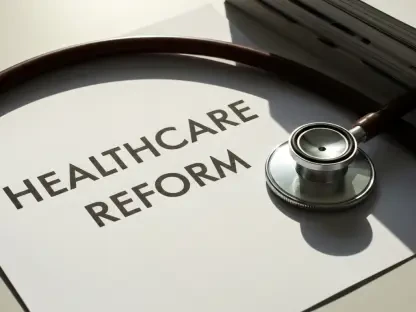The European Health Data Space (EHDS) regulation represents a monumental shift in handling health data across the European Union, endeavoring to create a unified registry that could revolutionize healthcare access and research capabilities. Central to its successful implementation is the element of patient trust, which can make or break its effectiveness. The regulation’s long-term success hinges on how well patients are informed about data handling and their influence over such processes. To shed light on this crucial aspect, this article examines the intricacies of the EHDS, its phased timeline, and the critical need for transparent communication to foster trust among patients. As EU member states refine their strategies to operationalize this regulation, understanding its impact is vital for stakeholders across the healthcare ecosystem.
Timeline and Objectives of the European Health Data Space
Initial Steps toward Data Integration
The EHDS regulation, now in effect as of March 2025, outlines a schedule for rolling out comprehensive data-sharing capabilities across the EU by March 2029. This timeline details specific stages to streamline healthcare access and bolster cross-border research. Initially, the focus is on sharing primary health data such as patient summaries, electronic prescriptions, and dispensations. These foundational elements are crucial for establishing a seamless flow of information among healthcare providers and improving care continuity for patients traveling or relocating within the EU. With a clear timeline, stakeholders can align their processes to secure the necessary infrastructure and governance, setting the stage for the next phases in data expansion.
Expanding the Scope of Data Utilization
From 2029 onward, the EHDS is set to broaden its reach by including secondary data elements by 2031, which encompass medical images, laboratory results, and hospital discharge reports. This expanded scope aims to enhance research capabilities, enabling healthcare professionals and researchers to draw more comprehensive insights from a wealth of data sources. External access to the data is projected to start by March 2034, allowing countries outside the EU and pharmaceutical entities to apply for secondary utilization through the HealthData@EU initiative. This future-focused strategy underscores the intent to leverage data beyond clinical settings, contributing to advancements in public health and medicine through shared knowledge across borders.
Building Patient Trust through Transparent Communication
Addressing Concerns and Promoting Awareness
Establishing robust patient trust is a linchpin in the successful implementation of the EHDS. Patients must be thoroughly educated about how their health data is collected, stored, and shared. Transparent communication strategies that emphasize “what’s in it for me” from the patient’s perspective are crucial. This involves elucidating the tangible benefits that data sharing can bring, including better treatment outcomes and the potential for more personalized healthcare. Engaging with patient advocates to disseminate clear information is a recommended approach, helping patients grasp the wider implications of data sharing—spanning from individual healthcare improvements to collective advancements in medical research.
Counteracting Misinformation and Ensuring Clarity
In the current digital age, there are growing concerns about misinformation campaigns that could undermine patient confidence in data-sharing initiatives by unnecessarily escalating fears about data privacy breaches. Maria Bäcklund Hassel of the Swedish E-Health Agency has accentuated the importance of educating patients on both the positives of data sharing and the safety mechanisms employed to protect their information. By proactively communicating the strict safeguards and de-identification processes in place, healthcare providers can combat public trepidation and emphasize the security protocols enforced throughout the data-sharing process. Positive engagements with patients ensure they make informed choices about participation in the EHDS initiative without succumbing to exaggerated fears.
Maintaining Control and Empowering Patients
Patient Autonomy in Data Sharing
The EHDS prioritizes giving patients control over their personal data, offering them the autonomy to opt-out of data sharing if they wish. This person-centered approach acknowledges patient rights, empowering them to dictate which aspects of their health information can be accessed by healthcare professionals and researchers. Jaanika Merilo from Estonia’s Ministry of Social Affairs advocates for this regulation’s ethos, highlighting the willingness to place patients in authoritative positions regarding their health data. This level of control not only reassures patients about their data privacy but also garners trust as they know they are not involuntarily implicated in any data-sharing initiative.
Comprehensive Benefits for Research and Innovation
The assured patient participation facilitated by the EHDS has profound implications for research, particularly due to the wealth of secondary health data it exposes. This data is pivotal in advancing precision medicine—an emerging paradigm that tailors treatments to individual patient profiles. For researchers like Malene Fischer at Copenhagen University Hospital, access to expansive datasets paves the way for transformative developments in treating rare diseases, creating digital twins, and optimizing treatment plans with higher predictive accuracy. Incorporation of secondary data also enhances pharmaceutical research, potentially shortening drug development cycles and enriching clinical trial designs with deeper real-world evidence.
Potential Advantages for Healthcare and Innovation
Enhancing Healthcare Outcomes Through Data
The systematic integration of EHDS is poised to have far-reaching implications for healthcare outcomes across Europe. By facilitating streamlined access to comprehensive, accurate health data, caregivers can deliver more precise and effective treatments that cater to the unique needs of each patient. This tailored approach leads to significant improvements in care quality, particularly for individuals with complex or chronic conditions who benefit most from data-driven insights. Hospitals, clinics, and medical professionals could refine therapeutic strategies based on broader patterns observed across the union, aligning treatment plans more closely with emerging medical knowledge and patient expectations.
Broadening Global Research Horizons
On a global scale, the centralization of health data inherent in the EHDS augments Europe’s position as a leader in medical research and technological innovation. By generating synthetic data sets of an unprecedented scale, the EU reinforces its competitive edge in the burgeoning field of healthcare analytics. The integration fosters an ecosystem where discerning patterns in significant datasets becomes feasible, accelerating advancements in diverse areas such as public health policy, genomics, and epidemiology. This progress stands to influence international research collaborations, elevating the EU’s stature by contributing valuable insights to global health challenges and setting a standard for data-driven healthcare solutions worldwide.
Conclusion: Building a Foundation with Trust and Transparency
The EHDS regulation, effective from March 2025, sets a timeline for deploying extensive data-sharing capabilities across the EU by March 2029. This schedule outlines distinct phases designed to enhance healthcare access and stimulate cross-border research efforts. Initially, the initiative prioritizes sharing essential health data like patient summaries, electronic prescriptions, and dispensations. These core elements are vital for creating a seamless information flow among healthcare providers, which is essential for improving care continuity for patients traveling or relocating within the EU. Having a clear timeline enables stakeholders to synchronize their processes to establish the necessary infrastructure. As these foundational stages are established, they pave the way for subsequent phases in data expansion, fostering a robust framework for healthcare data exchange. Ultimately, this strategic rollout aims to optimize healthcare delivery and research collaboration throughout the European Union.









